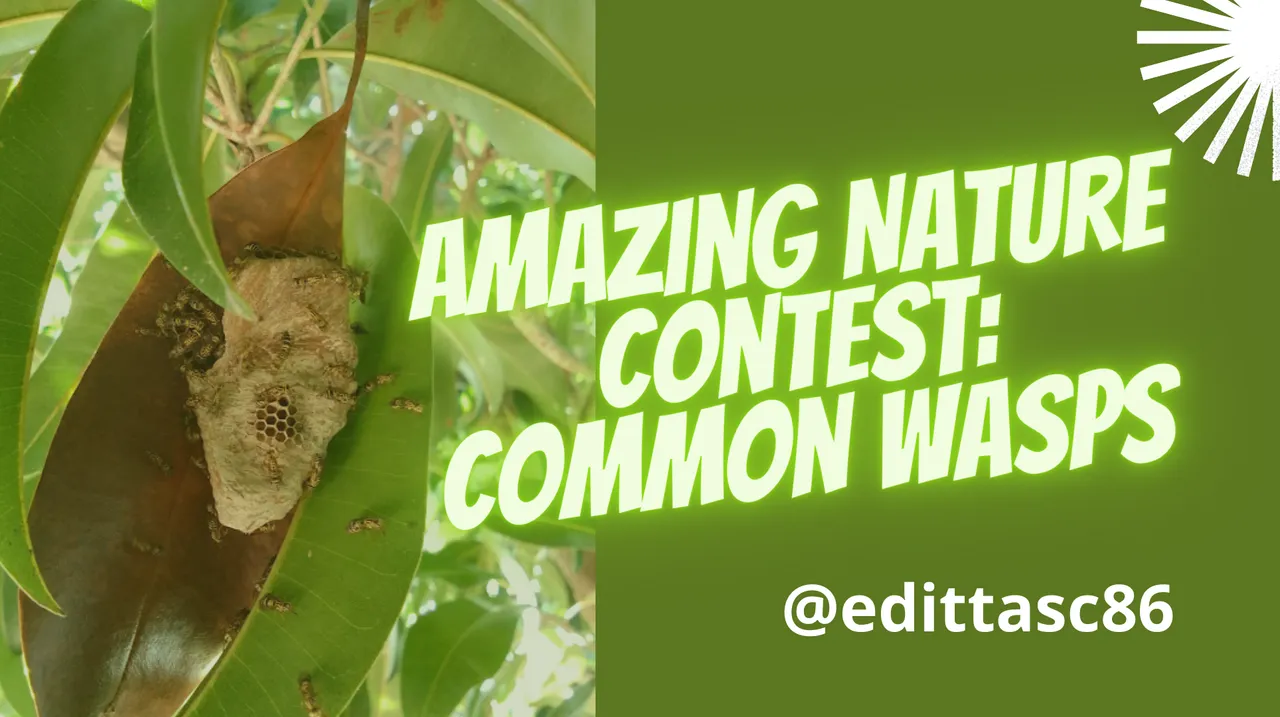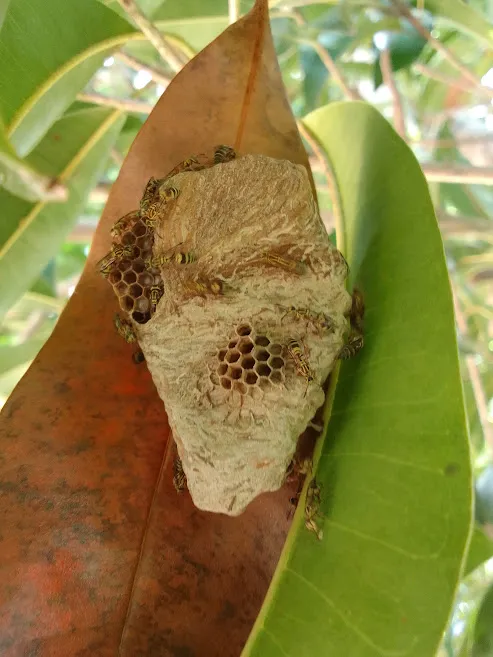
Nature is amazing, in it we find millions of species and many others that I still do not know, full of mysteries, I had never really been very interested in that part of nature until a few years ago perhaps with maturity when we began to give value to the little things.

I had always been afraid of insects, of being stung by them, especially wasps and bees, well actually any insect that stings. But now I feel respect for them, understanding what each one of them means to the environment.
There are millions of wasps of different species and sizes, some more dangerous than others, I am Venezuelan, there are a variety of species, but I only know the fearsome African wasps and the common ones, their name vespula vulgaris, are the ones I come to show you here.

This species lives in colonies, they build their hives using wood fibers that are chewed by them and yes by "them" because the worker wasps are the ones who build the nests, I find super impressive the perfection with which they make their hives, really magnificent.
The queen wasps are the ones that initiate a new colony, when the workers emerge, which are also sterile, they are in charge of feeding the queen and the youngest ones, besides, as I said before, the construction of the hive, by that time the queen is only in charge of her eggs.
Basically the life cycle of common wasps ends in winter when the workers and males die with the environmental conditions, only the queen wasps usually survive giving rise to a new colony and a new cycle.

They feed on flower nectar, sweet foods and fruits, usually stinging females. Wasps help us with pollination just like bees, the male is the one who visits the flowers in search of nectar, which helps the production of fruits and seeds, they help us as pest controllers wasps leaving the nest in search of food usually paralyze other insects chew them and take this to the nest to feed other wasps helps us keep our crops free of other insects such as aphids, caterpillars, spiders.
As you read wasps also help our environment and therefore us with our food, I think it is wonderful.
The pictures are taken in my backyard in a loquat tree.
It is my first time to make a post for this community and I do it in this initiative ... I hope you like my participation ...
La naturaleza es asombrosa, en ella nos encontramos con millones de especies y muchas otras más que aun desconozco, llena de misterios, nunca en realidad me había interesado mucho en esa parte de la naturaleza hasta hace unos años quizás con la madurez cuando le comenzamos a dar valor a las pequeñas cosas.

Siempre les había temido a los insectos, a ser picadas por ellos sobre todo a las avispas y abejas bueno en realidad a cualquier insecto que pique. Pero ahora siento respeto por ellos, al comprender lo que significa para el ambiente cada uno de ellos.
Las avispas hay millones de diferentes especies y tamaños, unas más peligrosas que otras, yo soy venezolana hay variedad de especies, pero yo solo conozco las africanas temibles y las comunes su nombre vespula vulgaris son las que vengo a mostrar por acá

Esta especie vive en colonias, construyen sus colmenas utilizando fibras de madera que son masticadas por ellas y si por “ellas” porque las avispas obreras son quienes construyen los nidos, me parece súper impresionante la perfección con las que realizan sus colmenas, realmente magnifico.
Las avispas reinas son las que inician una nueva colonia, cuando surgen las obreras que son también estériles, se encargan de alimentar a la reina y a las más jóvenes además como dije anteriormente de la construcción de la colmena, para ese momento pues la reina solo se encarga de sus huevos.
Básicamente el ciclo de vida de las avispas comunes termina en invierno cuando las obreras y los machos mueren con las condiciones ambientales, solo las avispas reinas suelen sobrevivir dando lugar a una nueva colonia y aun nuevo ciclo.

Se alimentan de néctar de flores, de alimentos dulces, frutas suelen picar las hembras. Las avispas nos ayudan con la polinización al igual que las abejas, el macho es quien visita las flores en busca de néctar, lo que ayuda a la producción de frutos y semillas, nos colaboran como controladores de plagas las avispas que salen del nido en busca de alimentos por lo general paralizan a otros insectos los mastican y llevan esto al nido para alimentar a otras avispas nos ayuda a mantener libre a nuestros cultivos de otros insectos como pulgones, orugas, arañas.
Como leen las avispas también ayudan a nuestro medio ambiente y por consiguiente a nosotros con nuestros alimentos me parece maravilloso.
Las fotografías son tomadas en el patio de mi casa en un árbol de níspero.
Es mi primera vez que realizo un post para esta comunidad y lo hago en esta iniciativa.. espero sea de su agrado mi participación..

Pictures of my property
Location: my house
Device: realme c11
Cover and banner made in Canva
References consulted avispas and avispas comunes